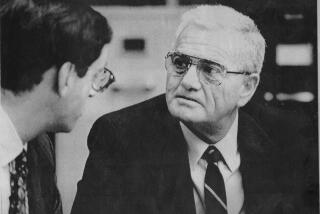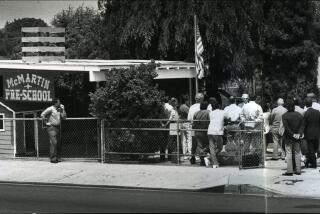Memory, Pain and the Truth
SAN FRANCISCO — Psychologist Elizabeth F. Loftus was instantly suspicious when she read about a 17-year-old called “Jane Doe” who purportedly had recovered a memory of her mother sexually molesting her as a child.
The claim, published by two psychiatry professors in a professional journal, was being hailed as proof of “repressed memory,” a theory that says the mind avoids intense pain by sealing off recollection of traumatic events. Under the theory, the victim may recover the memory accurately years later, usually in therapy.
The Jane Doe study contradicted everything that Loftus had been saying in lecture halls and courtrooms around the country. A professor at UC Irvine, Loftus is a leading figure in the so-called memory wars, a divisive dispute about whether repressed memory is the biggest fraud to hit psychology in decades or the outcome of careful therapy in which patients are able to heal themselves by finally coming to grips with painful pasts.
Mindful of the power of case studies to spur diagnoses and change therapeutic practices, Loftus decided to investigate. Her “expose” of Jane Doe would ignite a firestorm over the ethics of revealing information about subjects of case studies and a legal battle over privacy rights that has reached the California Supreme Court.
Stepping outside the confines of academia and working with two private eyes, Loftus tracked down the family of Jane Doe and published an article casting doubt on whether the girl had ever been abused. She questioned the methods of the psychiatrist who reported both the initial abuse in 1984 and the recovered memory of it 11 years later and portrayed the accused mother as the true victim.
Even though Loftus revealed no names or hometowns, Jane Doe retaliated, claiming in a lawsuit that she had been abused again, this time by an internationally recognized psychologist probing her private affairs for “professional and commercial exploitation.”
Loftus, 60, is tenacious and fearless in her work, though it doesn’t necessarily show in a first meeting. Unassuming, with an air of vulnerability, she has shoulder-length dark blond hair and wears rimless glasses. She dresses with a hint of the 1960s, softening a professional black suit with a floppy black hat and calf-high boots.
Scholars have ranked her among the top psychologists of the 20th century. She has been elected to the National Academy of Scientists, won the Grawemeyer Prize -- the largest monetary prize in psychology -- and written 20 books and more than 400 scientific articles.
Her work has been influential. The American Psychological Assn. “has raised a lot of red flags about the notion of recovered memories,” a spokeswoman said. “The general consensus is that it is very rare.”
Loftus also has testified or consulted about the fallibility of memory in hundreds of trials, including the McMartin Pre-School and Hillside Strangler cases. During the course of her trial work, she made enemies.
Critics saw her as a silencer of the sexually abused, even though she once startled a courtroom by testifying that she, too, had been sexually molested, by a male baby-sitter.
Her confrontation with believers in repressed memory, including alleged sexual abuse victims, grew so intense that one campus she visited assigned a guard to accompany her to a lecture. A bullet-riddled paper target hangs in her office at UC Irvine, a testament to her firearms training in the face of threats on her life.
At the same time, Loftus has become a hero to people who say they were falsely accused because of others’ “repressed” memories. They show up at her lectures to thank her, and she greets them like old friends.
Loftus feared the Jane Doe study would encourage more false charges. “I can’t stand to see injustice,” she said. “I just can’t stand it.”
Loftus called her probe of the case “my own little innocence project.”
*
The Jane Doe study was published in the May 1997 issue of Child Maltreatment. The primary author, Dr. David L. Corwin, said he had first interviewed Jane as a 6-year-old in 1984 during a custody battle.
In the videotaped interview, the little girl told Corwin that her mother repeatedly put her finger up her vagina while bathing her and admonished her to tell no one. She also said her mother burned her feet on a stove.
It was Corwin’s professional opinion that the mother had abused the child. The father won custody, and the mother eventually lost visitation rights.
Corwin, with permission from the father, showed Jane’s videotape at conferences on child abuse. Ten years after his first contact with Jane, Corwin called her and her father for renewed permission to use the videotape. The father was then in a convalescent home recovering from a stroke, and the teenager was living in a foster home.
Jane gave her permission and called Corwin a year later to ask to view the video. She was 17, and her father had died. Corwin agreed to meet her, and her foster mother went along.
Jane told the psychiatrist she could no longer remember being abused by her mother. She remembered only the accusation.
“Do you remember anything about the concerns about possible sex abuse?” Corwin asked while videotaping her.
“No,” she replied, and closed her eyes. “I mean, I remember that was part of the accusation, but I don’t remember anything -- wait a minute, yeah, I do.”
Jane then said she remembered a number of things, including the bathing incident, and Corwin played the videotape of her at age 6.
“The little girl that I see in those videotapes I don’t see as [having] made up those things.... I’m glad now that I don’t have to keep trying to convince myself that my dad ever lied to me ... I can put my dad’s memory to rest in my mind.”
Corwin mentioned “traumatic amnesia” in his subsequent study and described Jane’s experience as a “spontaneous return” of a “reportedly unrecallable memory.” With Jane’s permission, he showed the new videotape at national and international conferences.
Experts to whom Corwin had shown the videotapes offered favorable commentary and independent analysis in the child abuse journal.
Paul Ekman, a renowned psychologist who specializes in detecting deception, wrote that Jane’s recounting of the abuse as a child allows “us to have confidence in [her] truthfulness.”
*
Loftus was not persuaded. Typing the words “burned feet” and “Dr. Corwin” into an Internet search engine, she found a court case about the custody fight in Modesto. LexisNexis, death records and newspaper obituaries yielded other clues.
She called Melvin J. Guyer, a psychology professor at the University of Michigan. Guyer had been an expert witness in a trial in which Corwin had testified on the other side. Guyer, too, was suspicious and agreed to join Loftus in probing the Jane Doe story.
Loftus hired a private eye to pull the divorce records in Stanislaus County and asked a friend, also a private eye, to pull records in Solano County, where Jane had moved with her father. She and Guyer flew to Sacramento and drove to Modesto. They read the court records and interviewed Jane’s stepmother, biological mother, foster mother and half brother.
Loftus said she felt “like a millionaire” when her sleuthing paid off. “I am very proud of the fact I found these people,” she said.
The girl’s mother cried when she met with the professors, describing the loss of her daughter as a nightmare. Loftus stayed in touch through notes, calls and cards.
“As you can imagine, I am the heroine of this mother, dropping in out of the blue after more than a decade after she lost visitation and custody,” Loftus said.
Loftus also contacted Jane Doe by e-mail.
“I have no interest in furthering your research as it has already caused me enough pain and heartache,” Jane told Loftus. To try to block Loftus, she filed an ethics complaint at the University of Washington, where Loftus was then teaching.
The university promptly confiscated Loftus’ files, ordered her to speak to no one about the case and investigated her conduct for nearly two years.
“I was put under this horrible investigation where I was gagged from talking about this case,” she said. “I had been a good-girl faculty member -- I served on committees and worked hard -- so I felt pretty betrayed by the institution where I had taught at that point for 27 years.”
The university eventually exonerated Loftus of scholarly misconduct, but two of three members of a review committee suggested she take a remedial ethics course.
Freed at last to publish her research, Loftus “decided I had to get this thing out fast and try to stop it from being used against another innocent person.”
Corwin’s study already had become a potent weapon in the memory wars, Loftus said. Psychology professors presented it in their classrooms. Expert witnesses cited it in courtrooms. Lawyers considered it proof of repressed memory.
Loftus called a contact at the New Yorker, who told her the article was probably too academic for the magazine. She considered submitting it to a scholarly journal but knew that would mean a lengthy review process that would delay publication. “I felt there was a clock ticking, and every day that it was delayed was another day that someone was going to be harmed by this case,” Loftus recalled.
She submitted the article to the Skeptical Inquirer, a publication of the Committee for the Scientific Investigation of Claims of the Paranormal. The nonprofit scientific and educational group encourages investigation of “fringe science” claims.
“I knew it would be available on the Web,” Loftus said.
“Who Abused Jane Doe? The Hazards of the Single Case History” emphasized the contentiousness of the battle for Jane Doe’s custody, an arena particularly prone to false abuse accusations.
Loftus and Guyer observed that Child Protective Services had investigated Jane’s allegations and taken no action, a fact they found significant because authorities at the time were quick to believe and prosecute charges of child abuse.
The professors also disclosed that a psychologist who had interviewed Jane, her mother, father and stepmother during the mid-1980s and reviewed records remained unconvinced of the abuse charges.
That psychologist, whom Corwin had not mentioned, said the girl sounded “mechanical” when she made the charges. It was never proved that the mother burned the girl’s feet, the professional concluded. In fact, the child had a fungus condition that caused her skin to blister and peel.
Whereas Corwin’s case study had presented the mother as a shady character, Loftus and Guyer portrayed the father as dishonest and alcoholic.
They also questioned whether Corwin should have shown Jane her childhood videotape. The girl’s foster mother said it upset her, and she began to behave in “self-destructive” ways, the professors wrote.
“In sum, we believe that there are ample reasons to doubt whether Jane Doe was physically or sexually abused by her mother, and to doubt much of the ‘supporting evidence’ used to support the hypothesis,” they wrote.
*
Corwin, now a professor of pediatrics at the University of Utah School of Medicine and medical director of a hospital-based child abuse program, viewed the article as an attack. He said he was surprised by “the arrogance of thinking years later they could reconstruct something better than those who had firsthand knowledge at the time.”
Jane Doe filed suit, identifying herself as Nicole Taus. Now 26 and an aviator in the Navy, Taus charged that Loftus invaded her privacy and defamed her.
Courts must protect confidentiality in case studies; otherwise “it will be open season on all anonymous human subjects of clinical and scientific research,” argued Julian J. Hubbard, a lawyer for Taus. Hubbard did not return telephone calls, and Taus could not be reached for comment.
The lawsuit accused Loftus of developing a personal and unprofessional relationship with Taus’ mother. When Taus asked her mother to accept responsibility for the abuse, her mother retorted that “Loftus told her it had never happened,” the lawsuit said.
The suit also suggested that Loftus may have embraced Taus’ mother because of the “suicide” of her own mother, who was found dead one morning in a swimming pool when Loftus was 14. The death was not ruled a suicide, and Loftus prefers to think it was an accident.
Citing an article Loftus wrote in Psychology Today, the suit described Loftus’ “sense of guilt for being an adolescent who didn’t know her time with her mother was limited” and reported that Loftus now feels “she works too much and that what she really wanted was a family.”
Guyer, asked if the relationship between Loftus and the mother was appropriate, said he would have kept a greater distance. But “Beth wears her heart on her sleeve.”
The lawsuit also accused Loftus and her collaborators of reporting on court records that were supposed to be confidential and using deceit to obtain interviews, charges Loftus strongly denies.
*
In ruling on Taus’ suit in April, a Court of Appeal in San Francisco said that Loftus defamed Taus when she said in a lecture in 2002 that “Jane Doe” engaged in “destructive” behavior after seeing her childhood videotape and then disclosed that Taus was in the military.
Although Loftus had revealed no details about the “destructive” behavior, the appeals court reasoned that a listener might infer Taus was unfit for service.
The California Supreme Court will soon decide whether to accept an appeal by Loftus. If the state high court takes it, privacy law in California will probably be clarified for subjects like Jane Doe and academics and journalists who write about them.
If the court rejects the case, Loftus, her collaborators and the magazine will be forced to go to trial or try to reach a financial settlement with Taus.
Nearly 50 psychologists and psychiatrists, most of them university professors, have asked the state’s highest court to intervene.
“The manner in which people remember and report past traumatic events is one of the most controversial issues confronting the mental health field today,” the scientists wrote. If scientists can be sued for pursuing research, “then the scientific method and all the fruits of scientific endeavors are under grave threat,” they said.
The litigation has been grueling for Loftus, and she suspects her “enemies” in the memory wars are behind it. One of them, a believer in repressed memory, stalks her and “infiltrated” the lecture in which she disclosed that Jane Doe served in the military, Loftus said.
But Loftus said she was glad that she helped a mother who was “railroaded.”
“It makes me feel like a great human being,” Loftus said.
More to Read
Sign up for Essential California
The most important California stories and recommendations in your inbox every morning.
You may occasionally receive promotional content from the Los Angeles Times.











